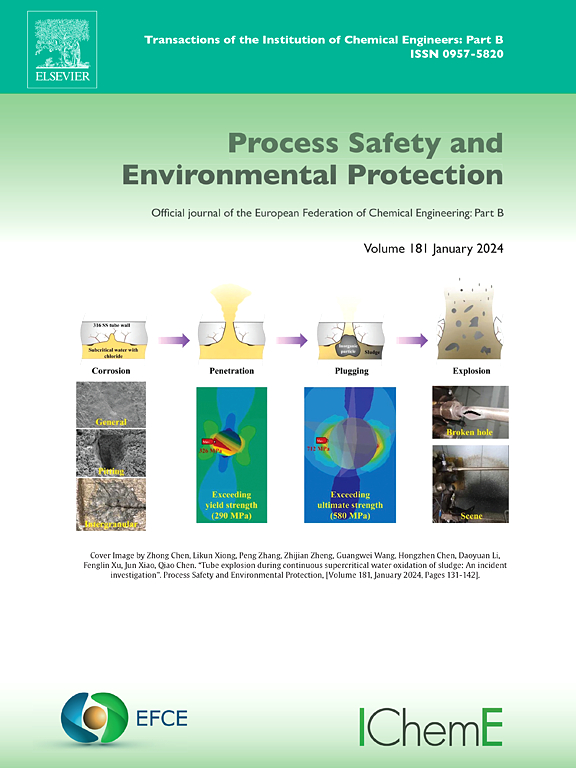化学混凝过程中絮凝体粒径分布及图像纹理演化特征分析
IF 6.9
2区 环境科学与生态学
Q1 ENGINEERING, CHEMICAL
引用次数: 0
摘要
化学混凝过程中絮凝体的动态演化特性对水处理工艺优化起着至关重要的作用,但对反应条件和絮凝体形态的实时监测仍然具有挑战性。本研究创新性地将机器视觉与图像纹理分析相结合,系统研究混凝剂投加量和原水浊度对絮凝体粒径分布和纹理特征的调控机制。采用无创高速成像系统捕捉絮凝全过程,结合Python-OpenCV算法对絮凝参数进行定量表征。结果表明,在浊度不变的情况下:(1)混凝剂用量不足导致胶体失稳不足,表现为絮团数量减少,图像灰度均值、熵和相关值显著降低;(2)最佳投加量可使絮团粒径分布集中,变异系数(CV)低;(3)过量会引起絮凝体侵蚀和破碎,形成双/三模态分布,CV显著增加。此外,高浊度原水加剧了絮团破碎,导致粒径分布分散(CV升高),光散射增强(纹理对比度提高)。本工作首次阐明了图像纹理特征与絮凝体粒径分布之间的协同演化,确认了它们作为实时混凝剂优化的敏感指标的潜力,从而为混凝过程的智能控制提供了理论基础。本文章由计算机程序翻译,如有差异,请以英文原文为准。
Characteristic analysis of floc size distribution and image texture evolution in chemical coagulation process
The dynamic evolution characteristics of flocs during chemical coagulation play a critical role in water treatment process optimization, yet real-time monitoring of reaction conditions and floc morphology remains challenging. This study innovatively integrates machine vision with image texture analysis to systematically investigate the regulatory mechanisms of coagulant dosage and raw water turbidity on floc size distribution and textural features. A non-invasive high-speed imaging system was employed to capture the entire flocculation dynamics, coupled with Python-OpenCV algorithms for quantitative characterization of floc parameters. Results demonstrate that under constant turbidity: (1) Insufficient coagulant dosage leads to inadequate colloidal destabilization, manifested by reduced floc quantity and significant decreases in image gray mean, entropy, and correlation values; (2) Optimal dosage produces concentrated floc size distribution with low coefficient of variation (CV); (3) Overdosing induces floc erosion and fragmentation, forming bi-/tri-modal distributions with substantially increased CV. Furthermore, high-turbidity raw water exacerbates floc fragmentation, resulting in dispersed size distribution (elevated CV) and enhanced light scattering (improved texture contrast). This work first elucidates the synergistic evolution between image textural features and floc size distribution, confirming their potential as sensitive indicators for real-time coagulant optimization, thereby providing theoretical foundations for intelligent control of coagulation processes.
求助全文
通过发布文献求助,成功后即可免费获取论文全文。
去求助
来源期刊

Process Safety and Environmental Protection
环境科学-工程:化工
CiteScore
11.40
自引率
15.40%
发文量
929
审稿时长
8.0 months
期刊介绍:
The Process Safety and Environmental Protection (PSEP) journal is a leading international publication that focuses on the publication of high-quality, original research papers in the field of engineering, specifically those related to the safety of industrial processes and environmental protection. The journal encourages submissions that present new developments in safety and environmental aspects, particularly those that show how research findings can be applied in process engineering design and practice.
PSEP is particularly interested in research that brings fresh perspectives to established engineering principles, identifies unsolved problems, or suggests directions for future research. The journal also values contributions that push the boundaries of traditional engineering and welcomes multidisciplinary papers.
PSEP's articles are abstracted and indexed by a range of databases and services, which helps to ensure that the journal's research is accessible and recognized in the academic and professional communities. These databases include ANTE, Chemical Abstracts, Chemical Hazards in Industry, Current Contents, Elsevier Engineering Information database, Pascal Francis, Web of Science, Scopus, Engineering Information Database EnCompass LIT (Elsevier), and INSPEC. This wide coverage facilitates the dissemination of the journal's content to a global audience interested in process safety and environmental engineering.
 求助内容:
求助内容: 应助结果提醒方式:
应助结果提醒方式:


